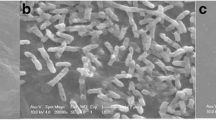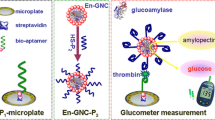Abstract
The fucosylated Golgi protein 73 (fuc-GP73) has been used as a criterion to distinguish hepatocellular carcinoma (HCC) from other chronic liver diseases. We describe an amperometric aptasensor for ultrasensitive detection of fuc-GP73 that uses a thiolated aptamer against GP73 as the capture probe, and gold nanoparticles (AuNPs) modified with Avidinlens culinaris agglutinin (A-LCA) as the detection probe. The AuNPs on the surface of a gold electrode provide a large surface for immobilization of A-LCA, so that they can be heavily loaded with biotinylated horse radish peroxidase (B-HRP) via avidin-biotin interactions. This results in enhanced analytical sensitivity. Under optimized conditions and a typical working potential as low as 48 mV (vs. SCE), the dynamic response of the electrode covers the 10 pg·mL−1 to 25 ng·mL−1 fuc-GP73 concentation range, with a 7 pg·mL−1 detection limit (for an S/N ratio of 3). The assay is precise, selective and reproducible. It was applied to the determination of fuc-GP73 in serum.

Schematic of an electrochemical aptasensor for the determination of fucosylated golgi protein 73 (fuc-gp73) based on the avidin-Lens culinaris agglutinin (A-LCA) and biotinylated horse radish peroxidase (B-HRP). It was applied to serum analysis with good sensitivity, selectivity and reproducibility.






Similar content being viewed by others
References
Mao Y (2010) Golgi protein 73 (GOLPH2) is a valuable serum marker for hepatocellular carcinoma. Gut 59(12):1687–1693
Block TM, Comunale MA, Lowman M, Steel LF, Romano PR, Fimmel C, Tennant BC, London WT, Evans AA, Blumberg BS (2005) Use of targeted glycoproteomics to identify serum glycoproteins that correlate with liver cancer in woodchucks and humans. Proc Natl Acad Sci U S A 102(3):779–784
Marrero JA, Romano PR, Nikolaeva O, Steel L, Mehta A, Fimmel CJ, Comunale MA, D'Amelio A, Lok AS, Block TM (2005) GP73, a resident Golgi glycoprotein, is a novel serum marker for hepatocellular carcinoma. J Hepatol 43(6):1007–1012
Hu B, Tian X, Sun J, Meng X (2012) Evaluation of individual and combined applications of serum biomarkers for diagnosis of hepatocellular carcinoma: a meta-analysis. Int J Mol Sci 14(12):23559–23580
Tian L, Wang Y, Xu D, Gui J, Jia X, Tong H, Wen X, Dong Z, Tian Y (2011) Serological AFP/Golgi protein 73 could be a new diagnostic parameter of hepatic diseases. Int J Cancer 129(8):1923–1931
Iftikhar R, Kladney RD, Havlioglu N, Schmittgräff A, Gusmirovic I, Solomon H, Luxon BA, Bacon BR, Fimmel CJ (2004) Disease- and Cell-specific expression of GP73 in human liver disease. Am J Gastroenterol 99(6):1087–1095
Maitra A, Thuluvath PJ (2004) GP73 and liver disease: a (Golgi) complex enigma. Am J Gastroenterol 99(6):1096–1098
Kladney RD, Cui X, Bulla GA, Brunt EM, Fimmel CJ (2002) Expression of GP73, a resident Golgi membrane protein, in viral and nonviral liver disease. Hepatology 35(6):1431–1440
Kladney RD, Bulla GA, Guo L, Mason AL, Tollefson AE, Simon DJ, Koutoubi Z, Fimmel CJ (2000) GP73, a novel Golgi-localized protein upregulated by viral infection. Gene 249(1–2):53–65
Drake RR, Schwegler EE, Malik G, Diaz J, Block T, Mehta A, Semmes OJ (2006) Lectin capture strategies combined with mass spectrometry for the discovery of serum glycoprotein biomarkers. Mol Cell Proteomics 5(10):1957–1967
Norton PA, Comunale MA, Krakover J, Rodemich L, Pirog N, D'Amelio A, Philip R, Mehta AS, Block TM (2008) N-linked glycosylation of the liver cancer biomarker GP73. J Cell Biochem 104(1):136–149
Jiang K, Shang S, Li W, Guo K, Qin X, Zhang S, Liu Y (2015) Multiple lectin assays for detecting glyco-alteration of serum GP73 in liver diseases. Glycoconj J 32(9):657–664. doi:10.1007/s10719-015-9614-6
Hao L, Yue H, Yue Y, Weiwei L, Yongmei Y, Genxi L (2015) Peptide-based method for detection of metastatic transformation in primary tumors of breast cancer. Anal Chem 87(18):9251–9256
Liu F, Gao T, Ye Z, Yang D, Wang Z, Li G (2014) An electrochemical method to assay human 8-oxoguanine DNA glycosylase 1. Electrochem Commun 50:51–54
Zhu X, Zhang B, Ye Z, Shi H, Shen Y, Li G (2015) An ATP-responsive smart gate fabricated with a graphene oxide-aptamer-nanochannel architecture. Chem Commun 51(4):640–643
Chen H, Mei Q, Hou Y, Zhu X, Koh K, Li X, Li G (2013) Fabrication of a protease sensor for caspase-3 activity detection based on surface plasmon resonance. Analyst 138(19):5757–5761
Zhu X, Shen Y, Cao J, Yin L, Ban F, Shu Y, Li G (2015) Detection of microRNA SNPs with ultrahigh specificity by using reduced graphene oxide-assisted rolling circle amplification. Chem Commun 51(49):10002–10005
Du J, Hong J, Xu C, Cai Y, Xiang B, Zhou C, Xu X (2015) Screening and identification of ssDNA aptamer for human GP73. Biomed Res Int 2015:610281–610281. doi:10.1155/2015/610281
Zhang J, Lv J, Wang X, Li D, Wang Z, Li G (2015) Integration of chemoselective ligation with enzymespecific catalysis: Saccharic colorimetric analysis using aminooxy/hydrazine-functionalized gold nanoparticles. Nano Res 8(12):3853–3863. doi:10.1007/s12274-015-0885-9
Yang Y, Li C, Yin L, Liu M, Wang Z, Shu Y, Li G (2014) Enhanced charge transfer by gold nanoparticle at DNA modified electrode and its application to label-free DNA detection. ACS Appl Mater Interfaces 6(10):7579–7584. doi:10.1021/am500912m
Gao T, Liu F, Yang D, Yu Y, Wang Z, Li G (2015) Assembly of selective biomimetic surface on an electrode surface: a Design of Nano-bio Interface for Biosensing. Anal Chem 87(11):5683–5689. doi:10.1021/acs.analchem.5b00816
Zhang J, Liu Y, Lv J, Li G (2014) A colorimetric method for α-glucosidase activity assay and its inhibitor screening based on aggregation of gold nanoparticles induced by specific recognition between phenylenediboronic acid and 4-aminophenyl-α-d-glucopyranoside. Nano Res 8(3):920–930
Huang Y, Li H, Gao T, Liu X, Li G (2014) A sensitive method for protein assays using a peptide-based nano-label: human glypican-3 detection for hepatocellular carcinomas diagnosis. Analyst 139(15):3744–3747
Acknowledgements
This work is supported by the National Natural Science Foundation of China (Grant Nos. 81602737, 81672307), and the Science Foundation of Jiangsu Province, China (Grant No. BM2015023).
Author information
Authors and Affiliations
Corresponding authors
Ethics declarations
The author(s) declare that they have no competing interests.
Electronic supplementary material
ESM 1
(DOCX 105 kb)
Rights and permissions
About this article
Cite this article
Li, J., Wang, B., Gu, S. et al. Amperometric low potential aptasensor for the fucosylated Golgi protein 73, a marker for hepatocellular carcinoma. Microchim Acta 184, 3131–3136 (2017). https://doi.org/10.1007/s00604-017-2334-9
Received:
Accepted:
Published:
Issue Date:
DOI: https://doi.org/10.1007/s00604-017-2334-9




